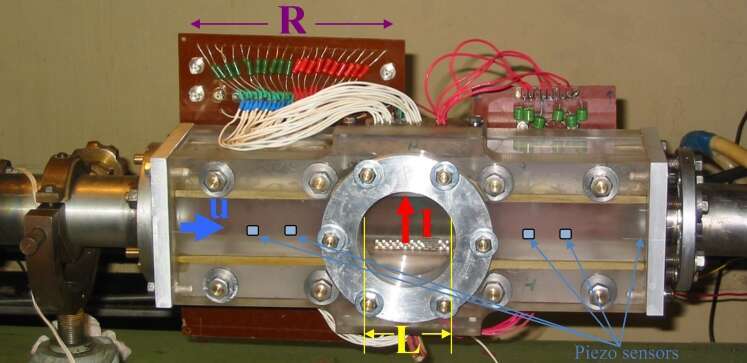The problem of action on strong gasdynamic breakdowns including different origin shock waves with the purpose of control or considerable weakening of them is important not only for applied science but interesting for fundamental investigations. For solving of this task for supersonic flows with Mach number more than 4 the plasma action method is actual from the point of view of operation speed. Plasma method supposes to use the gas discharges and plasma jets of different nature and intensities. In the row of papers for the purpose of supersonic flow and boundary layers control high energy plasma sheets [1], low current Dielectric Barrier Discharge (DBD) [2] and plasma jets [3] are used. In this paper the propagation of strong shock waves through the gas discharge which is formed in advance is investigated. In the previous papers the gas discharge action on the bow shock wave at supersonic flow around body by means of arranging of it in the flow before body [4] or near body’s surface in the region between bow shock wave and body [5] and the process of gas discharge closing by shock wave which passes through the region of applying uniform electrical field [6] were investigated. The strong influence of incoming to the body non equilibrium plasma flow and surface discharge on the position and form of the bow shock wave up to destruction of it were founded (Figure 1).
a) b) c)
Figure 1. Destruction of the bow shock wave at a flow around body by nonequilibrium plasma: a) Te/Th =2.9 regular bow shock wave; b) Te/Th=5.1 unstable bow shock wave; c) Te/Th=5.3 destruct bow shock wave.
Process of the shock wave propagation through electrical field (Figure 2) shown that the discharge switches on with some delay after shock wave coming to the region of voltage applying and initial discharge of current closing which moves behind shock wave with lower on 20% velocity is appeared. After the shock wave and initial discharge living from the region of electrical field applying the uniform gas discharge glows. The velocity of initial discharge propagation and secondary discharge uniformity does not depend from shock wave intensity and value of apply voltage.

Figure 2. Schlieren pictures of shock wave and initial discharge passage through the electrical field region at applying voltage V=140V.The time of frame exposure is 500 ns, and the period between frames is 15 mks, the width of observation zone is 80 mm.
The main goal of this work part is to investigate the propagation process of strong shock wave through the region of formed in advance gas discharge with different intensities from low current up to powerful current and through the region of afterglow. The investigation is carried out in direct channel (Figure 3) which connects with shock tube where shock wave formation is carries out. The discharge is arranged by means of special tyratron schemes which close discharge current in specified moment of time. The voltage is applied in advance to bottom and top electrodes which are built in channel. It is possible to vary the gas discharge intensity by means of changing of applying voltage value and the width of it by changing of number of connected electrodes. Additionally it is possible to switch on the gas discharge in fixed time moment before shock wave entrance to the region of discharge current closing for investigation of influence of relaxed in afterglow plasma. For compare of degree of action on shock wave the comparison of propagation velocity of shock wave before action region and after of it was chosen as main criteria. For this purpose the special piezo sensors were built in channel wall before action zone and after of it. Additionally a changing of shock wave form and intensity by means of schlieren method and measurement of dynamic pressure by front piezo sensor is obtained. The piezo sensors positions are shown on Figure 3.

Figure 3. Photo of the direct channel with gas discharge zone.
The investigation allows obtaining the actions on passed shock wave both of a power current discharge action which is supplied by hitting effect mainly and of a low current discharge action which connects with action of non equilibrium low ionized plasma and the same way action of relaxed in afterglow plasma. The set up allows varying the intensity both of the discharge and of the formed in shock tube shock wave.
References
- Jin, J., Znamenskaya, I. A., Sysoev, N. N., “Two regimes of pulsed volume discharge action upon a shock wave”, Technical Physics Letters, 39, Issue: 5, P. 418-42.
- Staricovskiy, M.Post, N.Tkach and R.Miles “Dielectric Barrier Discharge Control and Thrust Enhancement by Diode Surface” AIAA Paper-2014-0144, AIAA Science and Technology Forum and Exposition (SciTech2014), National Harbor, Maryland, USA, Jan.13-17, 2014.
- Venkat Narayanaswamy, Noel T. Clemens and Laxminarayan L. Raja, “Investigation of a pulsed-plasma jet for shock / boundary layer control” AIAA 2010-1089, 48th AIAA Aerospace Sciences Meeting and Exhibit and 12th Weakly Ionized Gas Workshop, Orlando, Florida, Jan.4-7, 2010.
- Lapushkina, A. Erofeev, S. Poniaev and S. Bobashev, “Investigation of Nonequilibrium Gas Discharge Plasma Supersonic Flow Around Body” AIAA-2008-1383, 46th AIAA Aerospace Sciences Meeting and Exhibit and 10th Weakly Ionized Gas Workshop, Reno, Nevada, Jan.7-10, 2008.
- Erofeev, T. Lapushkina, S. Poniaev and S. Bobashev, “Supersonic Body Streamline at Different Configuration Gas Discharge” AIAA Paper-2010-1382, 48th AIAA Aerospace Sciences Meeting and Exhibit and 12th Weakly Ionized Gas Workshop, Orlando, Florida, Jan.4-7, 2010.
- A.V.Erofeev, T.A.Lapushkina, S.A.Poniaev, “Shock Wave Propagation through Region of Electrical and Magnetic Fields Action” AIAA Paper-2014-0828, AIAA Science and Technology Forum and Exposition (SciTech2014), National Harbor, Maryland, USA, Jan.13-17, 2014.

